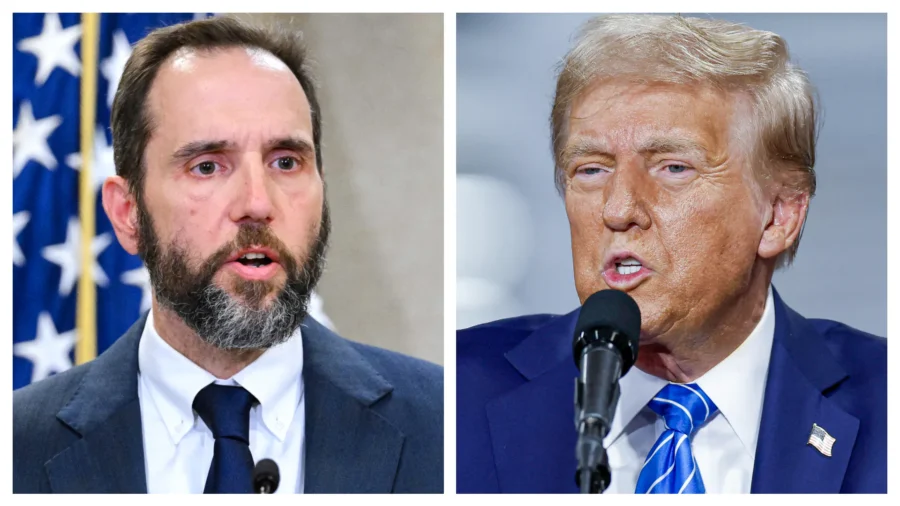Former President Donald Trump filed a brief on Oct. 3 to dismiss two counts in special counsel Jack Smith’s superseding indictment based on the Supreme Court’s ruling in a separate case that covers laws used by Smith.
The Supreme Court ruled this summer that the Justice Department had used too broad an interpretation when applying the Sarbanes-Oxley financial reform law to Jan. 6 defendants. The obstruction provision they ruled on—Section 512(c)(2)—is the basis for one of Trump’s counts and implicated in another.
“[Fischer v. United States] requires the dismissal of Counts Two and Three of the Superseding Indictment, and its logic fatally undermines Counts One and Four as well,” Trump said in his Oct. 3 filing.
“Section 1512(c)(2) was enacted in response to corporate document shredding that bears no resemblance to the allegations in the Superseding Indictment,” the filing reads. Smith used 1512(c)(2) and 1512(k)—which underlie counts three and two respectively—to argue Trump conspired and attempted to obstruct the election certification proceedings on Jan. 6, 2021.
Trump previously filed a similar motion to dismiss targeting the use of Sarbanes-Oxley in Smith’s original indictment. Last year, Smith responded by saying that Trump’s obstruction included attempting to marshal false electors to send false certifications to former Vice President Mike Pence.
“The defendant also sought to deceive state officials into undertaking efforts to derail the January 6 certification proceeding through direct overtures from him and his co-conspirators working outside the Executive Branch,” Smith’s reply brief reads.
Fischer v. United States
The Supreme Court’s decision in the case focused on whether Smith erred in attempting to disentangle (c)(1) from (c)(2) in Section 1512.
The section reads: “Whoever corruptly—alters, destroys, mutilates, or conceals a record, document, or other object, or attempts to do so, with the intent to impair the object’s integrity or availability for use in an official proceeding; or otherwise obstructs, influences, or impedes any official proceeding, or attempts to do so, shall be fined under this title or imprisoned not more than 20 years, or both.”
Smith had argued that the law allowed prosecutions that targeted obstructive conduct in a catch-all way that included methods other than those mentioned at the beginning of the section.
A majority of the Supreme Court, including Justice Ketanji Brown Jackson, disagreed and held: “To prove a violation of §1512(c)(2), the Government must establish that the defendant impaired the availability or integrity for use in an official proceeding of records, documents, objects, or other things used in an official proceeding, or attempted to do so.”
Trump’s Oct. 3 brief makes many arguments as to why the statute doesn’t apply to his behavior. Among other things, it states that the Electoral Count Act (ECA), which sets up the process for certifying elections, allows for the possibility of “‘more than one return or paper purporting to be’ a certificate.”
It added that because “these tasks were required by the ECA, actual or attempted transmission of alternate certificates did nothing to impair the integrity or availability of any certificates.”
Motions to Dismiss
Trump’s brief was filed as a supplement to a forthcoming motion to dismiss Smith’s superseding indictment on statutory grounds. In response to the original indictment, Trump had filed motions to dismiss with various arguments including those related to federal law and the constitution.
His motion to dismiss based on presidential immunity resulted in the Supreme Court’s holding in Trump v. United States, stating that presidents enjoyed certain levels of immunity from criminal prosecution for official conduct. He is expected to file another motion to dismiss responding to the superseding indictment and Smith’s sweeping brief on immunity that was released by the district court on Oct. 2.
Trump’s brief on Oct. 3 also indicated he would reassert arguments about the First Amendment protecting his ability to speak about the election.
“President Trump expressed sincere and valid concerns about the integrity of the 2020 election pursuant to his authority as the Chief Executive,” his brief read.
It added that “once stripped of President Trump’s official acts subject to immunity and protected First Amendment political advocacy, the Superseding Indictment lacks sufficient factual allegations to support either element as required by Counts Two and Three.”
The brief also claims that Smith lacks evidence to adequately allege violations under the laws informing counts one and four.
It’s unclear how U.S. District Judge Tanya Chutkan will handle these arguments. She previously rejected his arguments for dismissal based on constitutional grounds.
Her opinion stated that it “is well established that the First Amendment does not protect speech that is used as an instrument of a crime, and consequently the Indictment—which charges Defendant with, among other things, making statements in furtherance of a crime—does not violate Defendant’s First Amendment right.”
From The Epoch Times

